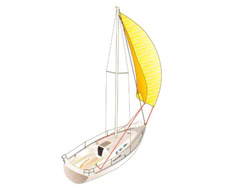
Asymmetrics, chutes and gennekers
Asymmetric spinnakers, cruising chutes and gennekers are basically one and the same.
They are similar to symmetrical spinnakers in that they are light,
colourful sails generally flown when the wind is on or aft of the beam,
but that is where the similarity ends. The sail shape resembles a baggy
loose luffed genoa and has a permanent luff, tack and clew. If a pole is
required it is usually a small one in the form of a bowsprit.

Equipment
- Spinnaker halyard - led from a block fixed above the forestay.
- Two
sheets - each about 2.5 times the length of the boat with snap-shackles
attached.
- Two swivel blocks - attached to each quarter.
- Tack line -
usually led from the bow to the cockpit. This is often adjusted to
change the shape of the sail or help gybing. Swivel block at the
stem-head or a bowsprit for the tack-line.
Set up
 The sail flies outside of the boat and so all lines should be rigged and led outside the shrouds, forestay and stanchions. The
spinnaker bag is attached to the leeward guardrail behind the genoa.
Lead the tack line from the cockpit through a block on the bow, or
through the bowsprit, and attach it to the tack.
The sail flies outside of the boat and so all lines should be rigged and led outside the shrouds, forestay and stanchions. The
spinnaker bag is attached to the leeward guardrail behind the genoa.
Lead the tack line from the cockpit through a block on the bow, or
through the bowsprit, and attach it to the tack.
Lead the sheets from
the clew, outside everything, to a block on each quarter, then to a
winch. Ensure the windward sheet is led outside of the forestay. Lead the halyard to leeward of the genoa and attach to the head of the spinnaker.

Hoist
Head onto a broad reach so the main and headsail shelter the sail as
it is hoisted. Adjust the tack-line until the tack is about 1m from the
stem head block or bowsprit. Secure the tack line.
Put a couple of turns around the winch of the leeward sheet, leaving
plenty of slack. Quickly hoist the halyard to the top of the mast, pull
in on the sheet as the sail starts to fill, then furl
the genoa away.
Trimming
 Using the tack line, the luff can be tightened when close to the wind
and eased when off the wind. Ease the sheet until the luff starts to
curl, then tighten until it stops curling. If the spinnaker is over
trimmed the boat sails slower and weather helm will increase. Check by
easing the sheet.
Using the tack line, the luff can be tightened when close to the wind
and eased when off the wind. Ease the sheet until the luff starts to
curl, then tighten until it stops curling. If the spinnaker is over
trimmed the boat sails slower and weather helm will increase. Check by
easing the sheet.
To sail on a reach pull in the tack-line to straighten the luff and sheet in.
To sail further off from the wind, ease the tack-line and sheet
allowing the sail to move in front of the boat providing more forward
drive and less heel.

Tactics
Asymmetrics get shielded by the mainsail when running downwind so the
preferred tactic is to broad reach and sail downwind in a series of
gybes. Whilst the course is longer, the speed is higher and both
mainsail and asymmetric work efficiently.

Gybing
- Gybing an asymmetric is very straightforward. Head onto a broad
reach.
- Ease the tack-line to give greater space between the luff of the
asymmetric and the forestay.
- Take up the slack on the new sheet and ease
the old sheet to pull the clew through the gap between the forestay and
the tack line.
- Gybe the main and trim the new spinnaker sheet
accordingly.
Dropping
- Bear away on to a broad
reach.
- Unfurl the genoa to reduce power in the spinnaker.
- Take hold of
the lazy sheet from under the boom and gather the spinnaker as the
halyard is eased.
- Stuff the sail down below deck through the
companionway hatch.

Words and photos:
Simon Jinks - RYA Instructor and Examiner at SeaRegs Training. www.searegs.co.uk
Illustrations taken from the RYA Sail Trim Handbook by Rob Gibson
Contact UsArticle Published: September 28, 2011 10:19
Article Updated: September 29, 2011 11:22
See Also
 By taking it one step at a time using a spinnaker will become a less daunting prospect.
By taking it one step at a time using a spinnaker will become a less daunting prospect.
 A run through the gear and preparation required for spinnakers.
A run through the gear and preparation required for spinnakers.
 Draft has two elements; the depth of draft and position of draft.
Draft has two elements; the depth of draft and position of draft.
 Using the kicker, mainsheet and traveller to best effect.
Using the kicker, mainsheet and traveller to best effect.
 Genoa trim is of particular importance when the wind is forward of the beam.
Genoa trim is of particular importance when the wind is forward of the beam.